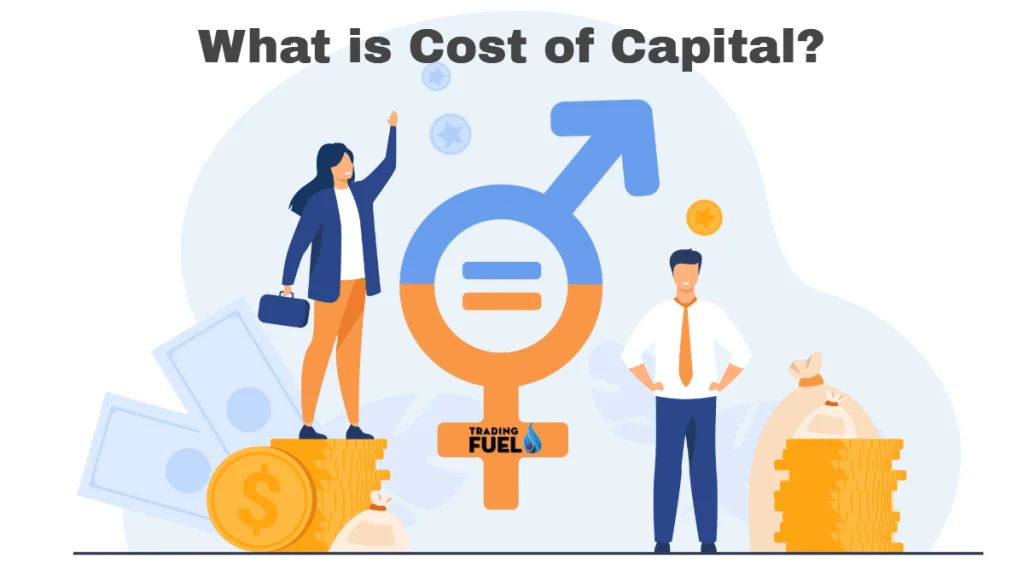
- 1 All About Cost Of Capital {WACC}
- 1.1 Basics Of Cost Of Capital {WACC}
- 1.2 Cost Of Debt and Its Effect On Cost Of Capital {WACC}
- 1.3 Different Types Of Debts And Their Affect On Cost Of Capital
- 1.4 Cost Of Equity And Its Effect On Cost Of Capital
- 1.5 Beta and Risk
- 1.6 Basics Of Risk
- 1.7 Formula and Types of Beta
- 1.8 Reason for calculate Levered Beta {BL} and Unlevered Beta {BU}
- 1.9 Relation between Levered Beta {BL} and Unlevered Beta {Bu}
- 1.10 Things must take in consideration for Calculating Levered Beta {BL} and Unlevered Beta {Bu}-
- 1.11 Calculation Of Unlevered Beta {BU} and Levered Beta {BL}
- 1.12 Calculation Of Cost of Capital {KE} by CAP Model
- 1.13 Full Calculation of Cost Of Capital {WACC}
All About Cost Of Capital {WACC}
Basics Of Cost Of Capital {WACC}
Meaning of cost of capital {WACC}
Cost of Capital {WACC} is a financial assessment of raised funds whether funds provide rapid growth and support the business in the long term or not. It checks the efficiency and effectiveness of raised funds form Company point of view. By Cost of Capital {WACC} metrics we calculate Cost of Debt, Cost of Equity and Beta of company
Simply Cost of Capital is simply a financial metrics to make sure that funds raised on affordable rate, so it used in the long term and help business to grow with their maximum potential. Generally, cost of capital expressed in percentage terms.
Need of cost of capital {WACC}
To evaluate different projects –

As you can see in the above diagram then you understand if Cost of Capital is more than expected Rate of Return then there is no point to invest in such type of project. So, management should evaluate other different projects for investment purpose for growth of company {By using NPV and IRR}
.
| Cost of capital for project A | 12% |
| Expected Returns | 10% |
As you can see in the above table management should not invest in Project A because company not even able to cover its cost of capital. So, calculation for Cost of Capital is crucial then it is easy for management to decide in which project they should invest
Evaluate different source of funds –
- There are numerous methods by which company can raise funds some of them are given below –
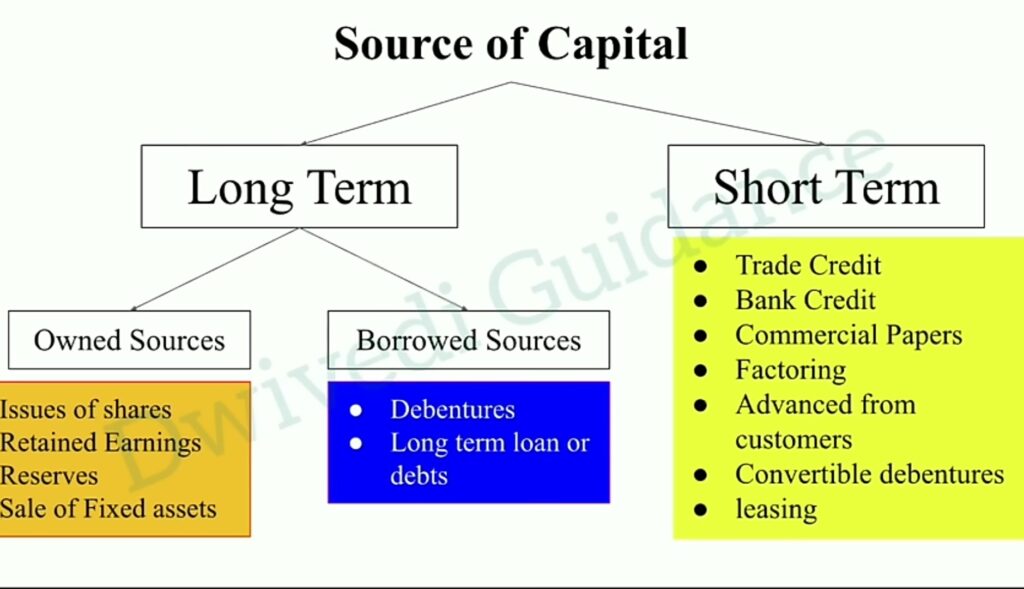
All sources of funds come with their own and different cost and risk, so which one is most suitable for the business is not decided randomly so in that case we calculate cost and risk associate with each source and create most suitable and appropriate Capital Structure by using WACC metrics for maximum utilization of the future growth and potential of the company.
Maintain Risk and cost –
When company decide to raise funds then the main aim of management is to create a balance in capital structure because if company raise more funds from debts, so it increases solvency risk of company and if company raise more funds from equity, then it increases cost of capital, so it is essential to make sure maintain balance in both types of funds for company stability so management performs Cost of Capital {WACC} analysis.
Make company financially sound
– First let us take an example for further understanding –
| ABC LTD. | |
| Gross Profit | 1000000 |
| 10% Debenture | 2000000 |
| 11% Bank loan | 3000000 |
| Rest profit for other business expenses | 4700000 |
If you analyze the above table, then you notice that ABC LTD. make a poor capital structure and failed to perform Cost of Capital {WACC} metric due to this there most of the profit is used to repay firms debt interest. So, it is necessary to evaluate Cost of Capital {WACC} properly, so company look financially sound, and market does not show adverse effect on the company
Advantages of cost of capital {WACC}
Help in Financing decision making
As we all know a company needs significant funds to invest in different projects in order to business growth in that situation sometime company have to raise funds from different sources for financing different projects in that case Cost of Capital {WACC} metric plays a crucial role for valuating fund sources and obtaining funds with minimum cost to avoid financial burden on the company.
Useful for capital budgeting
As I mentioned earlier company raise funds from different sources {Debt and Equity}in order to grow so it is necessary to maintain an optimum combination of Debt and Equity for the capital structure of the company, so the business does not suffer by excessive financial leverage, that is how Cost of capital {WACC}analysis performed by management to make a perfect combination of Debt and Equity for company future projects.
Evaluating Financial performance
When a company run its business then it is necessary for the management to calculate its return {Using NPV and IRR} if business returns is less than calculated Cost of capital for business then it is essential for the management to evaluate different aspects of the business in order to increase company financial performance and potential to grow and make higher profits.
Useful in Investment decision
When management has multiple projects ideas simultaneously to invest in order to increase company revenue than the first thing management has to do is to be evaluating all projects Cost Of Capital and its expected returns {By using NPV and IRR} and the project which is most profitable is chosen by the management.
Formula of Cost of Capital {WACC}
{Cost of debt * Weighted of debt} + {Cost of Equity * Weighted of Equity}
Other forms of this formula –
WACC = {KD*D/D+E} + {KE * E/D+E}
Here –
- KD = Cost of debt
- D/D+E = Weighted of debt {in %}
- KE = Weighed of Equity
- E/D+E = Weighted of Equity {in %}
- As you can see the formula of Cost of Capital {WACC} let us discuss it more deeply –
Cost Of Debt and Its Effect On Cost Of Capital {WACC}

Meaning of Cost of debt
Cost of debt is the extra/ additional cost that occurred due to borrowings {for financing business activities} which company pays. Simply Cost of debt is the other name of Interest which company pays on the raise of debts on the regular basis to its Debt holders.
How Cost of Debt affect Cost of Capital {WACC}
let us take an example to understand it much better.

- If you observe the above chart, then you can understand if company increase Cost of Debt rapidly then it leads to increase company solvency risk and if company used low debts in his capital structure, then its leads to increase company taxes (because debt interest is deductible from company income) and Cost Of Equity {KE} which ultimately increase Cost Of Capital {WACC} So, it must use Cost of Debt wisely for company future and financial soundness.
Important things you Must know before discussing about Cost of Debt {KD} To Calculate Cost of Capital
- Always use After tax {Tax adjusted amount} use for calculating Cost of Debt.
- IF company is not generating any profits so there will be no tax liability is levied on company in that case Before Tax adjusted amount is use for calculating Cost of Debt.
- Debt must be used wisely in capital structure to avoid Company Solvency risk
- Let us discuss different types of debts used by companies and their cost and how to calculate them.
Different Types Of Debts And Their Affect On Cost Of Capital
Bank loan
When company is in their early stage and even though some big companies also prefer to raise funds from bank because raising funds from bank does not contain too much regulation compare from Stock and Bond market also it is not containing too much additional cost other than interest and also bank provide low interest to big companies and high credit score firms {High credit worthiness}
- Calculation of bank interest rate –
Formula – loan Amount * interest rate * Total time in repayment
Debentures
Normally big companies prefer to raise funds by debentures. Debentures is a debt acknowledgment document means it is an official document of debt of fundraising for which company issue prospectors and request public to invest in company and in return company provide interest on regular basis till debentures maturity / redemption period
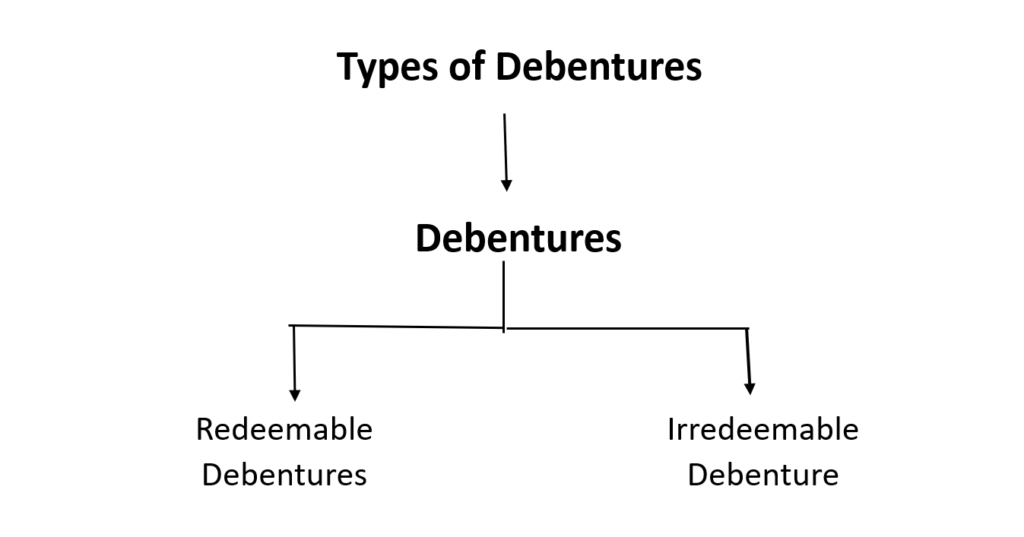
- Types of Issue and Redemption of Debentures –
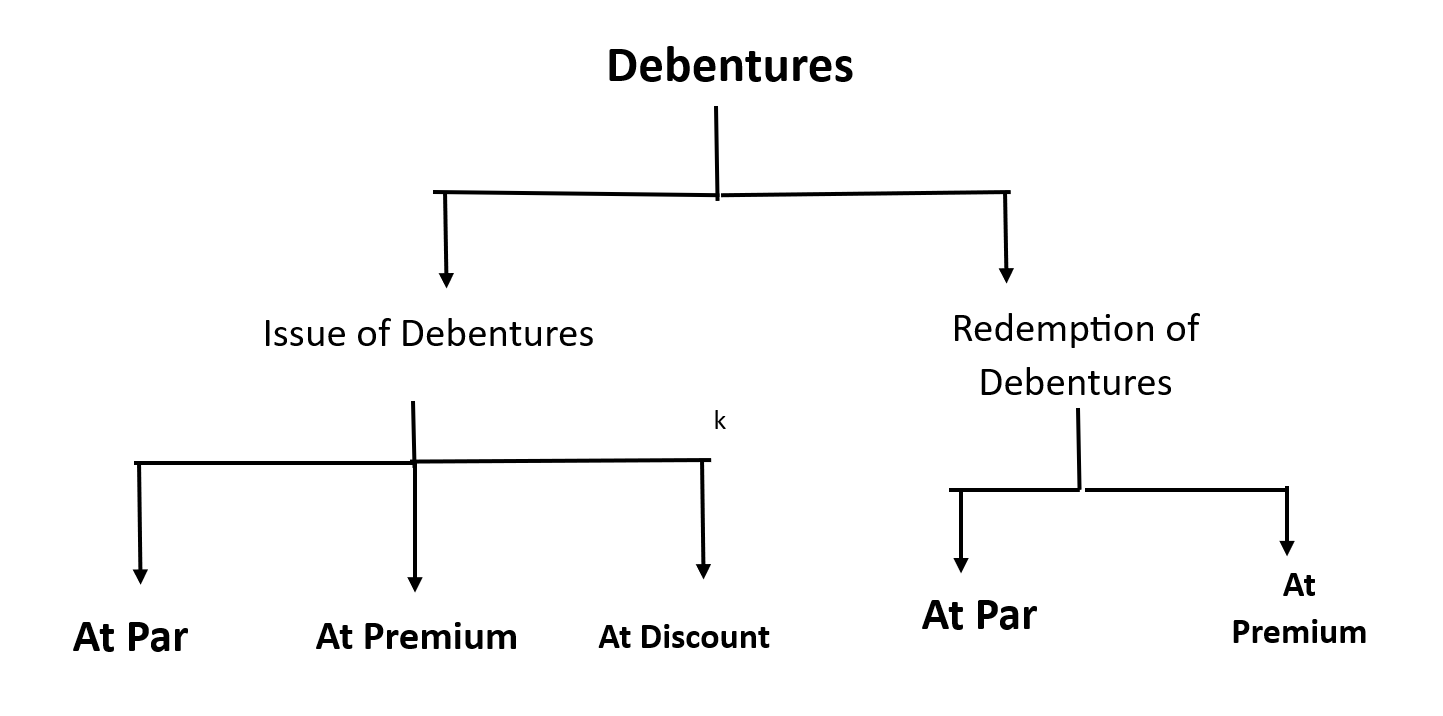
- As you can see how debenture issue and redeem through above table let us discuss them deeply.
- Issue / Redeem at par – when debenture issue at face value {Means Market price = Face Value of Debenture} it called Issue debenture at Par and when these debentures redeem at market price {Equal to Face value of Debentures} also then it called Redemption of Debenture at Par. Market price is not always equal to Face Value.
- Issue / Redeem at Premium – When company issue debenture higher than face value of Debentures {Face Value < Market Price} it is called Issue of Debenture at Premium and when redeem Debenture at higher than Face Value {Face Value < Market Price} it is called Redemption of Debenture at Premium.
- Issues Debenture at Discount – When company issue debenture lower than face value of Debentures {Face Value > Market Price} it is called Issue of Debenture at Discount. Debenture cannot redeem at discount.
Redeemable Debenture –
Redeemable debentures are those debentures which issue by the company for a specific period of time and when their maturity come these debentures will be redeemed by the company.
- Formula to Calculate Cost of Redeemable Debentures –

- KD = Cost of Debt
- I = Interest Amount on each Debenture
- t = Tax Rate
- RV = Redemption amount of each debenture
- NP = Current value of Debentures / Simply Issue price of each Debentures
- n = Number of years for which Debentures are issue.
- Let us take an example to understand Cost of Redeemable Debentures much better –
| ABC LTD. | |
| Tax Rate | 30% |
| Interest Amount on each Debenture | RS 10 |
| RV | 110 |
| NP | 100 |
| n | 5 |
- If you put these data in the formula so it looks like –
KD = 10{1 – 0.30} + {110 – 100 / 5} / {110 + 100 / 2}
KD = 0.857 *100 {To convert in %}
KD = 8.57% {Approx}
- Means the cost of debt incurred by raising funds from Redeemable Debentures is 8.57%. So that how Redeemable Debentures cost is calculated.
Irredeemable Debentures –
Irredeemable Debentures are basically those debentures which do not consist of any specific maturity / Redemption period these debentures redeem on day of company winding up {Means company operations completely shut down forever}. Generally, these Debentures are not issue by the companies.
- Formula to calculate Cost of Irredeemable Debentures –
Kd = I * {1 – t} / NP
- Let us take an example to understand Cost of Irredeemable Debentures much better –
| ABC LTD | |
| Interest Amount on each Debenture | RS 10 |
| Tax Rate | 30% |
| NP | 100 |
- If you put these data in the formula so it looks like
KD = 10 * {1 – 0.30} / 100
KD = 0.7 * 100 {To convert in %}
KD = 7%
- Means the cost of debt incurred by raising funds from Irredeemable Debentures is 7% So that how Irredeemable Debentures cost is calculated.
Cost Of Equity And Its Effect On Cost Of Capital
As we know all funds have their own risk and cost that we all understand earlier, and it also apply for Equity Shares. Expectations of Returns from Equity are cost of equity shares means all equity shares holder wants to gain appropriate return from invest in Equity Shares in long term. Equity shares is most expensive source for raise funds.
- Let us see how company share price will change by different factors.
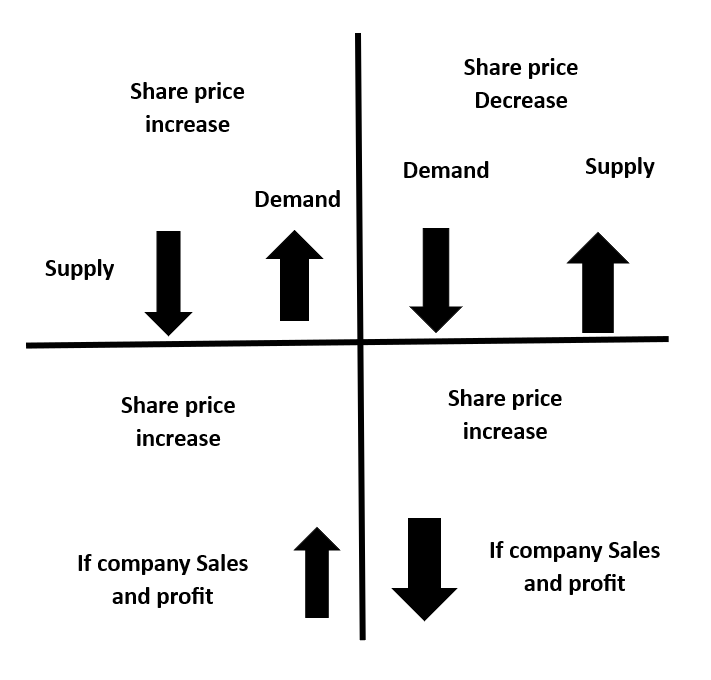
If you analyze the above diagram then you understand how share price will affect by numerous factors like Demand and Supply, Company fundamentals {like Competition, Competitive Edge, Business model etc.}. They all lead to increase or decrease Equity share price. That Affect Beta and it leads to increase of Cost of Equity {KE}
- As you now understand Cost of Equity is the Expectation of returns from shareholder, so it is impossible for company to know every investor expectation, so we use different methods to calculate Cost of Equity.
CAP Model to calculate Cost Of Equity {KE}
- KE = Rf + Beta {Rm – Rf}
- KE = Cost of Equity
- RF = Risk free return
- RM = Market Return
- Let us discuss CAP Model in detail
- Risk free return {RF} – This is a return / gain that investor earn without taking any specific risk. Like in India if any investor invests in FD, then he will earn 7% return for sure and that is Risk free return {Rf}
- Market Return {RM} – This is the average return that stock market gives to the investors in the long run. Like in India if any investor invests in Nifty 50 for 10 Years so the investor gets return around 12 – 13% on their investment and that is Market Return {Rm}.
Beta and Risk
Meaning of Beta
Beta is a metrics to measure systematic risk of a company, Beta measure how a specific company react towards market fluctuation and how company respond to Market. Simply Beta measure how much company follow market up and down trends.
Like ABC company beta is 2 means if means market up by 10% so ABC company share price goes up by 20% and if market down by 10% so ABC company share price goes down by 20%.
Basics Of Risk
What is Risk
In language of finance any deviation in the expected return on investment considered as Risk. Risk either be opportunity or Danger means either Risk can be positive or negative.
- Like expected return for ABC company is 12%. If they get return at rate of 10% or 15% both considered as Risk because both are different from expected return, but difference is 10% is negative {because it lesser than expected return} while 15% is positive {because it higher than expected return}.
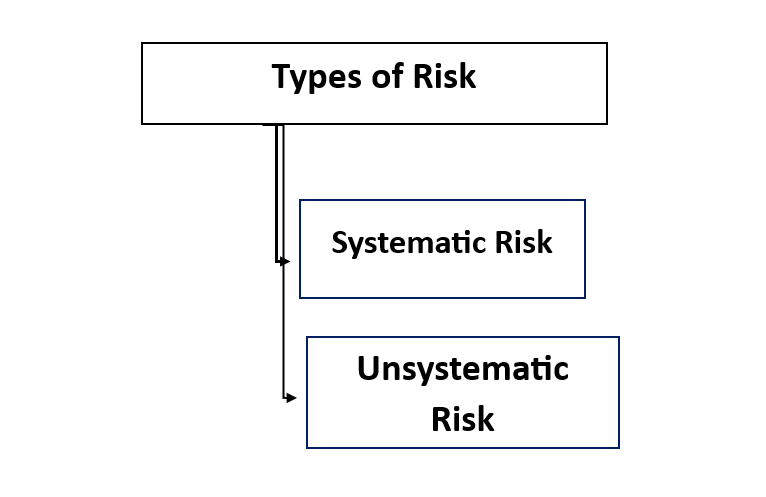
Systematic Risk
This type of risk affects not only a specific company or sector but affect whole market and has no control over systematic risk so we cannot avoid its consequences. like – War situation between countries, fluctuation in currency or anyone invest on whole market like by purchasing ETF. Systematic Risk is also called Undiversifiable Risk because it cannot reduce through diversification.
Unsystematic Risk
This type of risk affects only a specific company or sector, not whole market and we have some control over it, by diversify the portfolio we can avoid risk Unsystematic Risk and its consequences to some extent. Like – someone invested in Pepsi so he can invest in Coco cola also or invest in other sectors to reduce risk of his portfolio. Unsystematic Risk is also called Diversifiable Risk because it can reduce to some extent by diversify the portfolio.
- So, Beta is use for measure risk to calculate Cost of Equity.
Things you should know about Beta –
- Beta measure only Systematic Risk.
- It is used to calculate Market and Sector Risk also.
- It gives knowledge about fluctuation of a specific stock
- Beta tells about how a specific share reacts and respond to market
- Those shares make less movement according to market are immune from market means their share price not highly affected by market.
- Those shares make high movements according to market is not immune from market means their share price highly affect by market.
- 1 is considered as Market Beta.
Determinates of Beta –
- Financial leverage of the company – Debt proportion in the capital structure
- Nature of Business.
- Operating leverage of the company – Composition of fixed and variable capital in the company.
Beta movements
| Beta value | Reaction towards market |
| Beta > 1 | Low beta / less reactive towards market |
| Beta = 1 | Follow market movement |
| Beta < 1 | High beta / highly reactive towards market |
Disadvantages of Beta
Lack of clarity – Calculation of Market Beta can be done in the different ways like on Daily, Weekly and Monthly basis so it cannot clarify how different persons and websites calculate Beta on which basis because they cannot clarify their method which create confusion and misunderstanding among investors also it manipulates some of the investors.
No future predication – Beta calculate on past performance basis so Beta lack in future projection of the company and market because market is very unpredictable and any news affect market on big level.
Avoid company earnings and growth – Beta takes only debt, equity and assets in consideration and avoid earnings and growth of the company for consideration which are two of the most important measures to evaluate any company, so Beta does not show exact picture of company and mis interpret some sectors or companies
Formula and Types of Beta
Formula = Covariance between Share returns and Market return / Variance of Market returns (Regression method}
- But it is important to remember that you cannot use above calculated beta directly in calculation of Cost of Equity for CAP Model because the above beta is average of market risk not for specific company or sector. So, in that situation investors have to calculate specific company beta. Above formula calculated Beta can be obtained on different websites.
- For specific calculation you have to know types of betas and how to calculate it.

Reason for calculate Levered Beta {BL} and Unlevered Beta {BU}
- Regression method {Covariance formula} cannot be used on private companies because their historical data is not available for public so it impossible to calculate Beta for private companies by Regression method {Covariance formula} because this need historical data. So, we use levered Beta specifically to calculate Risk of private companies.
- Through Levered Beta {BL} and Unlevered Beta {BU} investor specifically calculate specific beta for their target company and able to calculate Cost of Equity more accurately.
- Levered Beta {BL} beta used for calculation of WACC.
Levered Beta {BL}
Levered Beta shows what is the composition of Debt and Equity in the Capital Structure of a specific company means how much debt company raise other than equity and calculate the risk by taking financial leverage of company in consideration. Levered beta is also known as Equity Beta.
formula – Bu = BL / (1 + {1 – t} * D/E Ratio)
- BU = Unlevered Beta
- D/E Ratio = This shows the composition of Debt and Equity of a company Capital Structure. Ideal D/E Ratio is 2:1.
Unlevered Beta {Bu}
Unlevered Beta is a metrics that measure risk of a company without taking debt in consideration means in Unlevered Beta debt has not any impact on company risk and Unlevered Beta solely impact by Assets of the company means only assets possessed by company affect its risk under Unlevered Beta {Bu}. Unlevered Beta {Bu} is also called Assets Beta.
Formula – Bu = BL / (1 + {1 – t} * D/E Ratio)
Relation between Levered Beta {BL} and Unlevered Beta {Bu}
- BL = BU when company does not raise funds from debts.
- When company raise funds from debt then Levered Beta {BL} also increase
- When company increase debt in its capital structure then risk for Equity shareholders also increase and it also increase Cost of Equity. Hence Cost of Capital [WACC} also increase.
- Let us take an example to understand how risk for Equity shareholders increase
| ABC LTD. | ||||||
| Raise funds from Debt | Raise funds from Equity | Recovery Amount {1 crore} | Settle down to Debt holders | Settle down to Equity holders | Recovery {%} | Risk for Equity share holder {%} |
| 0 | 1 crore | 1 crore | 0 | 1 crore | 100% | 0% |
| 50 lakhs | 50 lakhs | 1 crore | 50 lakhs | 50 lakhs | 50% | 50% |
| 80 lakhs | 1.50 crore | 1 crore | 80 lakhs | 20 lakhs | 13.33% | 86.67% |
| 1 crore | 1 crore | 1 crore | 1 crore | 0 | 0% | 100% |
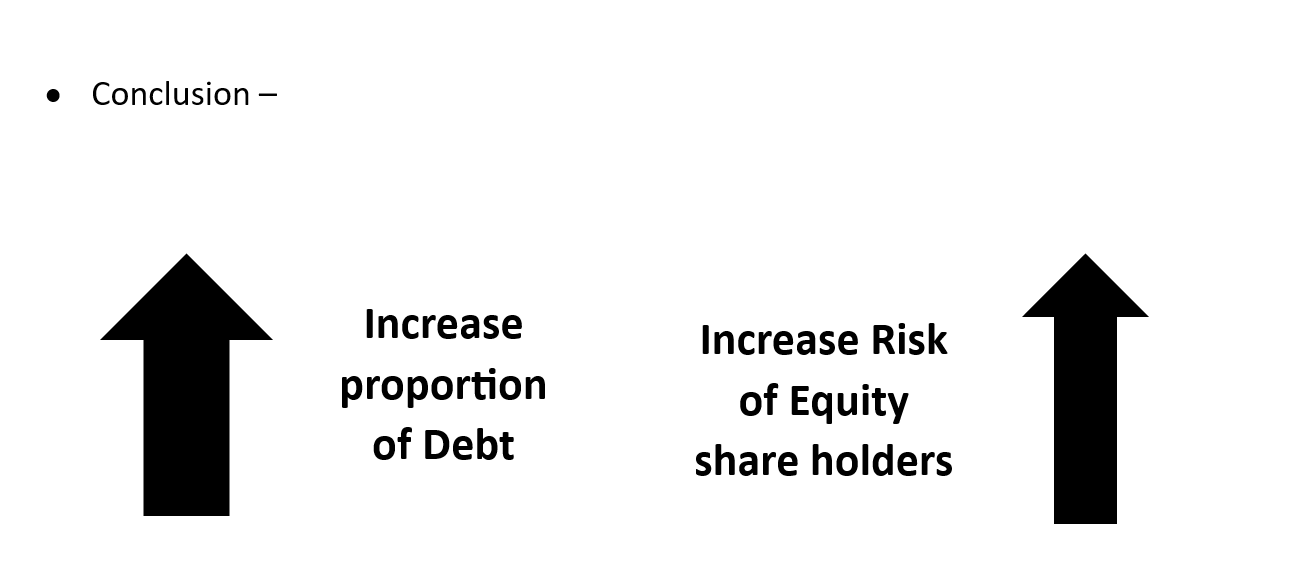
As you can see in the diagram when Debt proportion increase it also increased risk for equity. Hence Levered Beta {BL} also increase as result Cost of Equity also increase. That how debt affect Cost of Equity.
Things must take in consideration for Calculating Levered Beta {BL} and Unlevered Beta {Bu}-
- Always take levered Beta {Bl} of that industry / Sector in which company operate and convert into average Unlevered Beta {Bu} by analyzing Competitor’s Unlevered Beta {BU} for calculation no matter either it private company or public company.
- Then calculate target company levered Beta {Bl} for calculation of Cost of Equity and result use for calculation of WACC.
Calculation Of Unlevered Beta {BU} and Levered Beta {BL}
- Let us take an example to understand how to calculate Unlevered Beta {Bu} and levered Beta {Bl} –
- For calculation of Unlevered Beta {Bu}
| Beta of top 5 companies in XYZ sector | |
| A LTD Company Unlevered Beta {Bu} | 0.5 |
| B LTD Company Unlevered Beta {Bu} | 1.5 |
| C LTD Company Unlevered Beta {Bu} | 1 |
Let us calculate A LTD Company Unlevered Beta {Bu} again to understand how to calculate Unlevered Beta {Bu}
| A LTD | |
| levered Beta {Bl} | 1.2 |
| Tax rate | 30% |
| D/E Ratio | 2:1 |
- Formula – Bu = BL / (1 + {1 – t} * D/E Ratio)
Bu = 1.2 / (1 + {1 – 0.30} * 2/1)
Bu = 0.5
- Rest same calculates like above calculation
- Then the average Unlevered Beta {Bu} of the industry is
- Average Unlevered Beta {Bu} = 0.5 + 1.5 + 1 / 3 = 1
- Average Unlevered Beta {Bu} = 1
- So, this average Unlevered Beta {Bu} is used for calculation of levered Beta {Bl} of target company. Here you notice that we take top 3 companies as sample size if you want more precise result then you increase sample size.
- Let us calculate levered beta of target company –
| Ram LTD | |
| Unlevered Beta {Bu} | 1 |
| Tax rate | 30% |
| D/E Ratio | 1.2:1 |
- Calculations is look like
BL = BU (1 + {1 – t} * D/E Ratio)
BL = 1 (1 + {1 – 0.30} * 1.2:1)
BL = 1.84
- So now this levered Beta {Bl} is used for the calculation of Cost of Equity by CAP Model. That how levered Beta {Bl} calculate for Cost of Equity and Cost of Capital {WACC}
Calculation Of Cost of Capital {KE} by CAP Model
| Shyam LTD | |
| Unlevered Beta {Bu} | 0.6 |
| Tax rate | 35% |
| D/E Ratio | 2:1 |
| Risk free Return {Rf} | 7% |
| Market Returns {RM} | 12% |
First let us calculate levered Beta {Bl} for calculation of Cost of Equity –
{Bl} = BU (1 + {1 – t} * D/E Ratio)
{Bl} = 0.6 (1 + {1 – 0.35} *2/1)
{Bl} = 1.38
Now let us calculate Cost of Equity by CAP Model –
KE = Rf + Beta {Rm – Rf}
KE = 7 + 1.38{12 – 7}
KE = 13.9%
- Now if you look at the above expression result so you can understand that the Cost of Equity for Shyam LTD is 13.9% means Equity shareholders maintain an exaptation of 13.9% {around 14% return} from the Shyam LTD.
Full Calculation of Cost Of Capital {WACC}
| Anil CO. LTD. | |
| Interest amounts on per debenture | RS 10 |
| Tax on Debenture | 35% |
| RV | 110 |
| NP | 100 |
| n | 5 |
| Weight of Cost of Debt {KD} | 50% |
| RF | 7% |
| RM | 12% |
| Unlevered Beta {BU} | 0.5 |
| Tax on Company profits | 35% |
| D/E Ratio | 2:1 |
| Weight of KE | 50% |
- First calculate Cost of Debt {KD} –
KD = (I {1 – t} + RV – NP/n)/RV + NP/2
KD = (10{1 – 0.35} + 110 – 100/5)/ 110 + 100 / 2
KD = 0.0809 * 100 {To convert in %}
KD = 8.09%
- Let us calculate Beta first for Cost of equity {KE}
BL = BU {1 + {1 – t} * D/E}
BL = 0.5{1 + (1 – 0.35) * 2/1}
BL = 1.15
- Let us calculate Cost of Equity {KE}
KE = RM + Beta {RM – RF}
KE = 7 + 1.15{12 – 7}
KE = 12.75%
- Now lastly calculate Cost of Capital {WACC}
WACC = (Cost of Debt {KD} * Weight of Debt) + (Cost of Equity * Weight of Equity)
WACC = (8.09% * 50%) + (12.75% * 50%)
WACC = 0.1042 * 100 {To convert in %}
WACC = 10.42%
- So, the Cost of Capital {WACC} for Anil CO. LTD. = 10.42%
- So that how Cost of Capital {WACC} is calculated for any company you can calculate any company Cost of Capital {WACC} by the above process.
